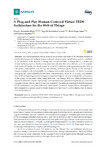Mostrar o rexistro simple do ítem
A plug-and-play human-centered virtual TEDS architecture for the web of things
| dc.contributor.author | Hernández-Rojas, Dixys | |
| dc.contributor.author | Fernández-Caramés, Tiago M. | |
| dc.contributor.author | Fraga-Lamas, Paula | |
| dc.contributor.author | Escudero, Carlos J. | |
| dc.date.accessioned | 2018-10-02T16:56:37Z | |
| dc.date.available | 2018-10-02T16:56:37Z | |
| dc.date.issued | 2018-06-27 | |
| dc.identifier.citation | Hernández-Rojas, D.L.; Fernández-Caramés, T.M.; Fraga-Lamas, P.; Escudero, C.J. A Plug-and-Play Human-Centered Virtual TEDS Architecture for the Web of Things. Sensors 2018, 18, 2052. | es_ES |
| dc.identifier.issn | 1424-8220 | |
| dc.identifier.issn | 1424-8239 | |
| dc.identifier.uri | http://hdl.handle.net/2183/21099 | |
| dc.description.abstract | [Abstract] This article presents a Virtual Transducer Electronic Data Sheet (VTEDS)-based framework for the development of intelligent sensor nodes with plug-and-play capabilities in order to contribute to the evolution of the Internet of Things (IoT) toward the Web of Things (WoT). It makes use of new lightweight protocols that allow sensors to self-describe, auto-calibrate, and auto-register. Such protocols enable the development of novel IoT solutions while guaranteeing low latency, low power consumption, and the required Quality of Service (QoS). Thanks to the developed human-centered tools, it is possible to configure and modify dynamically IoT device firmware, managing the active transducers and their communication protocols in an easy and intuitive way, without requiring any prior programming knowledge. In order to evaluate the performance of the system, it was tested when using Bluetooth Low Energy (BLE) and Ethernet-based smart sensors in different scenarios. Specifically, user experience was quantified empirically (i.e., how fast the system shows collected data to a user was measured). The obtained results show that the proposed VTED architecture is very fast, with some smart sensors (located in Europe) able to self-register and self-configure in a remote cloud (in South America) in less than 3 s and to display data to remote users in less than 2 s. | es_ES |
| dc.description.sponsorship | Xunta de Galicia; ED431C 2016-045 | es_ES |
| dc.description.sponsorship | Xunta de Galicia; ED341D R2016/012 | es_ES |
| dc.description.sponsorship | Xunta de Galicia; ED431G/01 | es_ES |
| dc.description.sponsorship | Agencia Estatal de Investigación de España; TEC2015-69648-REDC | es_ES |
| dc.description.sponsorship | Agencia Estatal de Investigación de España; TEC2016-75067-C4-1-R | es_ES |
| dc.language.iso | eng | es_ES |
| dc.publisher | M D P I AG | es_ES |
| dc.relation.uri | https://doi.org/10.3390/s18072052 | es_ES |
| dc.rights | Atribución 3.0 España | es_ES |
| dc.rights.uri | http://creativecommons.org/licenses/by/3.0/es/ | * |
| dc.subject | Sensors | es_ES |
| dc.subject | Actuators | es_ES |
| dc.subject | TEDS | es_ES |
| dc.subject | IEEE 21451 | es_ES |
| dc.subject | Internet of things | es_ES |
| dc.subject | Web of things | es_ES |
| dc.subject | Smart sensors | es_ES |
| dc.subject | Smart transducers | es_ES |
| dc.subject | Interoperability | es_ES |
| dc.subject | Human-centered services | es_ES |
| dc.title | A plug-and-play human-centered virtual TEDS architecture for the web of things | es_ES |
| dc.type | info:eu-repo/semantics/article | es_ES |
| dc.rights.access | info:eu-repo/semantics/openAccess | es_ES |
| UDC.journalTitle | Sensors | es_ES |
| UDC.volume | 18 | es_ES |
| UDC.issue | 7 | es_ES |
| UDC.startPage | 2052. | es_ES |
| dc.identifier.doi | 10.3390/s18072052 |
Ficheiros no ítem
Este ítem aparece na(s) seguinte(s) colección(s)
-
GI-GTEC - Artigos [190]






